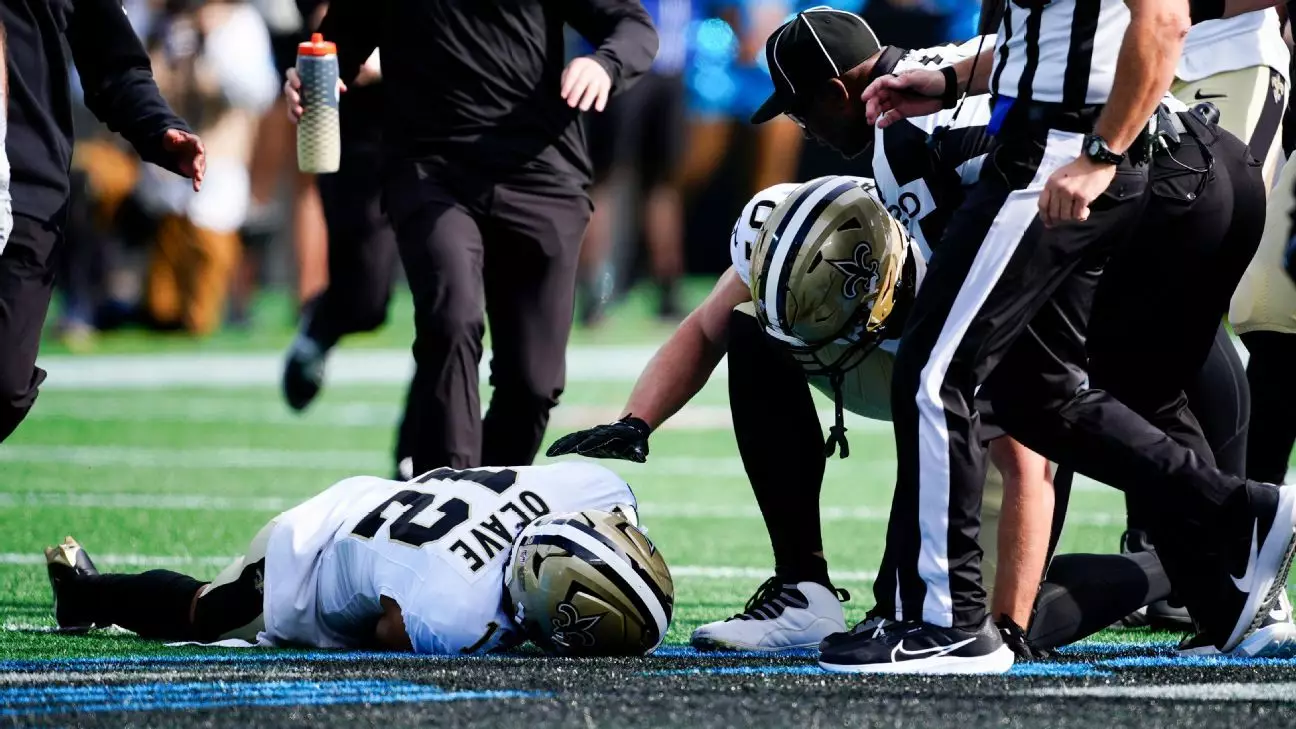The recent incident involving Chris Olave, wide receiver for the New Orleans Saints, has raised renewed concerns regarding player safety in the NFL, particularly in relation to concussions. This incident, which marked Olave’s second concussion of the season, highlights the continuous battle between player health and the intense physical demands of professional football. Olave’s situation also invites scrutiny into how the league addresses head injuries and the repercussions of player interactions on and off the field.
During the Saints’ narrow 23-22 defeat to the Carolina Panthers, Olave suffered a significant hit from safety Xavier Woods while attempting to make a catch. The play was ruled unnecessary roughness, revealing an ongoing concern about the frequency of such dangerous tackles in the league. Woods, having accrued the highest total of unnecessary roughness penalties since 2017, exemplifies the type of aggressive play that can lead to devastating injuries. Following the impact, Olave remained on the ground before being carted off, prompting concern from teammates and fans alike.
Beyond the immediate physical impact, Olave’s concussion raises important questions about how such incidents illustrate the broader challenges of managing player safety within an arena that values toughness and resilience. Chris Olave himself expressed gratitude for the support of fans and teammates via social media, reinforcing the emotional and psychological dimensions of injury recovery in professional sports.
Olave’s situation was made more urgent by his placement into the league’s concussion protocol for the fourth time in his career. The NFL has invested substantial resources into understanding and managing concussions, with evolving protocols aimed at protecting players. However, the efficacy of these measures remains questionable, especially given their implementation inconsistencies across teams and individual circumstances. While the league seeks to mitigate the long-term consequences of head injuries, the increase in concussions may indicate a need for more stringent enforcement of safer play guidelines.
In this regard, the NFL’s response to concussions must be scrutinized for effectiveness. Should protocols hinge solely on visible symptoms, or should they be preventative in nature? As players like Olave continue to surface with concussion-related issues, a reevaluation of existing policies might become necessary to protect the mental health of athletes who are often seen as invulnerable.
The response to Olave’s injury extended beyond mere sympathy. Former Saints wide receiver Michael Thomas took to social media to express his disdain for quarterback Derek Carr, attributing blame for the circumstances leading to Olave’s hit. This discord highlights the tensions that can arise within teams due to performance, injuries, and accountability. Thomas’s comments directed at Carr not only displayed frustration but also lagged deeper issues regarding team dynamics, individual performance, and how injuries can lead to a breakdown of trust among teammates.
While Thomas’ remarks might resonate with fans who seek accountability in athletic performance, they also underscore the stress placed upon players in high-stakes situations. Carr’s response indicated a willingness to diffuse the tension, expressing empathy for both Olave and Thomas. Yet, the situation illustrates how quickly player frustrations can morph into public disputes, complicating team morale and camaraderie.
As the NFL continues to grapple with the implications of injuries like Olave’s, it must prioritize a culture that underscores player safety without sacrificing the spirit of competition. This can involve standardized rules across teams regarding concussion protocols, as well as the enforcement of rules against dangerous hits. Furthermore, fostering open communication among players can significantly impact team dynamics, allowing for a space where athletes can address safety concerns and personal frustrations constructively.
In the wake of incidents like Olave’s, there exists not only a responsibility to protect players physically but also to acknowledge their emotional wellbeing as integral to their performance and longevity in the game. The league must work towards reshaping practices and protocols, ensuring they foster an environment where players feel valued, heard, and safe—both on and off the field. Only then can the NFL hope to navigate the delicate balance between the thrill of competition and the pressing need for player safety.

